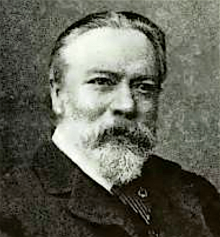
George Thomas Robinson [also known as George T. Robinson; Geo T. Robinson; and as G.T. Robinson] was born in Isleworth, Middlesex, England in 1829 and trained as an architect under John R. Hamilton and James Medland (1808-1894) in Gloucester, England. He commenced practice as an architect in Manchester in 1848 and was in partnership with Henry John Paull (1831-1888) as Paull & Robinson from 1867 to 1872.
Following the dissolution of his partnership with Paull, Robinson moved to London and in the latter part of his career he worked mainly as a decorative artist, particularly as as a decorative plasterer. He wrote the introduction to Plastering, Plain and Decorative. A Practical Treatise on the Art & Craft of Plastering and Modelling by William Millar (London: Batsford, 1899), a classic text on the subject, and wrote the essays 'Fictiles' and 'Of Stucco and Gesso' in Arts and Crafts Essays (London : Rivington, Percival, & Co., 1893).
Robinson was elected a Fellow of the Royal Institute of British Architects (FRIBA) in 1860 and was a Fellow of Society of Arts. He was a founding member of the Art Workers Guild in 1884 and spoke at their meetings on Alfred Stevens in 1889 and on modelling and cast plaster-work in 1896. He participated in the 2nd (1889 and 3rd (1890) exhibitions of the Arts & Crafts Exhibition Society at the New Gallery London.
Robinson was an art critic for the Manchester Guardian and in 1871 was dispatched by the newspaper to Metz in France to report on the siege of the city during the Franco-Prussian war. He subsequently came to be known as 'Metz' Robinson.
Robinson died in London on 6 May 1897.
A biographical file on Robinson is available on request at the Enquiry Desk, Royal Institute of British Architects Library in London
Architectural work by Robinson included Christ Church in Gailey, Stafforshire (1849-51); Public Baths in Wolverhampton, Staffordshire (1849-50); Church of St James in Brownhills, Walsall, Staffordshire (1850-51); the Market Hall in Wolverhampton, Staffordshire (1850-53); the Corn Exchange in Wolverhampton, Staffordshire (1850-53); St John’s Church in Bishopswood, Staffordshire (1851); Holy Trinity Church in Sneyd, Staffordshire (1851-52); the Market Hall Bolton, Lancashire (1851-55); the parsonage, Church of St James in Brownhills, Walsall, Staffordshire (1854); Town Hall in Burslem, Staffordshire (1854-57); the Market Hall in Tunstall, Staffordshire (1856-58); St. Luke's Church in Blakenhall, Wolverhampton, Staffordshire (1860-61); and the Market Hall in Montevideo, Uruguay (1868).
Directory of British Architects 1834-1914. Compiled by Antonia Brodie, et al. Volume 2: L-Z. London; New York: British Architectural Library, Royal Institute of British Architects/Continuum, 2001
‘Obituary’. The Art Journal July 1897 p. 222
‘Obituary’. Illustrated London News 15 May 1897 p.668